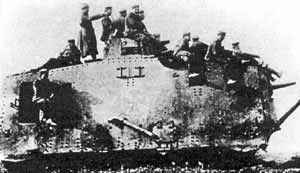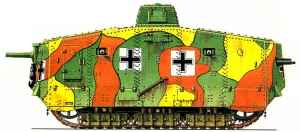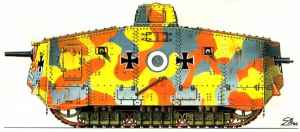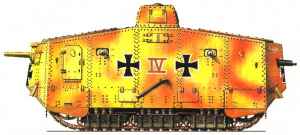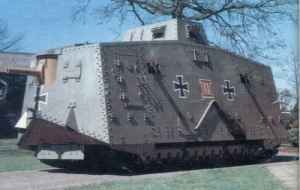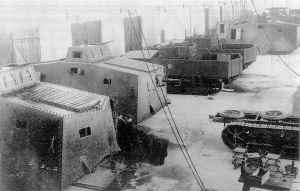| |
A7V - Allegmeine-Kriegs-Department 7, Abteilung Verkehrswesen (General War Department 7, Traffic Section) was designed in January of 1917 by Reserve Captain and Engineer Joseph Vollmer. General War Department 7, Traffic Section was raised in September of 1916, after first British tanks appeared on the battlefield. On November 13th of 1916, the German Army decided to build tanks and overall project was under direction of Joseph Vollmer. New tank was to be a universal platform to be used as a base for both a tank and cargo carrier. It was based on Holt tractor of which parts were obtained from Austria, where it was produced under licence. Vehicle was powered by two centrally mounted 100hp Daimler engines with commander's cupola / compartment above them. First prototype was completed by Daimler-Benz and tested in April of 1917. The wooden mock-up of a final version was ready in May of 1917. First pre-production A7V was produced in September of 1917, followed by production model in October of 1917. All tanks received nicknames (e.g. Mephisto, Wotan, Isolde etc.) and were grouped in 1st, 2nd and 3rd Abteilung. It had its tank vs. tank debut against British tanks on March 21st of 1918 at St. Quentin and on April 21st at Villers-Bretonneux / Cachy. Only 20 out of 100 ordered (in December of 1917) were produced due to the steel shortages and overall low priority of the project. A7V was unstable and had a very poor trench-crossing performance due to its track design and minimal ground clearance. Two production types existed, early type with hull sides made of number of pieces (with large number of rivets) and late type with one piece hull sides. There were other numerous differences between individual tanks since all parts were handmade and made to fit given tank. In addition, its poor quality armor plates offered little protection for 18 men (in some cases 22 men) crew composed of artillerymen, infantrymen and mechanics. The main armament consisted of 57mm (Russian Sokol or Belgian Maxim Nordenfeld) gun and six heavy machine guns. Additional weapons were carried by the crew of whom some fought alongside the tank during combat. Along with A7V tanks, 30 to 75 unarmored cargo carriers - Uberlandwagen / Gelandewagen were produced. Some cargo carriers were fitted with ditch digging machines Following the WWI, few (5?) tanks were received as reparations from Germany by Poland and pressed into limited service from 1919 to 1922, during the Polish-Soviet War but it has not been proven if Poland really received any A7V tanks. Today, original A7V Mephisto captured by Australian troops in 1918, can be seen in the museum in Brisbane, Queensland in Australia. Full scale replica build modelled after the original Mephisto can be seen at Panzermuseum at Munster, Germany.
|
|
|



